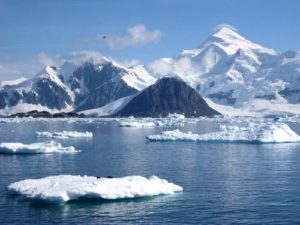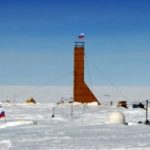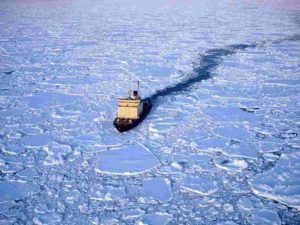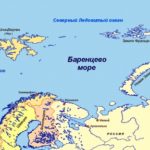Antarctic and Arctic ice
 Antarctic ice is predominantly annual. The total area of perennial ice is barely 0.02 million km2 here, and two-year-olds – 2.4 million km2. They are located near the Antarctic continent. To the north they are replaced by annuals. The main feature of the distribution of ice by age is their gradual rejuvenation from the center of the massif to its edges in the northern hemisphere and from the shores of Antarctica to the outer boundary of sea ice in the southern hemisphere.
Antarctic ice is predominantly annual. The total area of perennial ice is barely 0.02 million km2 here, and two-year-olds – 2.4 million km2. They are located near the Antarctic continent. To the north they are replaced by annuals. The main feature of the distribution of ice by age is their gradual rejuvenation from the center of the massif to its edges in the northern hemisphere and from the shores of Antarctica to the outer boundary of sea ice in the southern hemisphere.
The differences between the Arctic and Antarctic ice cover their cohesion. The ice cover of the northern hemisphere is a region of cohesive ice, surrounded by a rarefied periphery. During the year, this periphery changes, increasing in summer and shrinking in winter.
However, the overall picture of the distribution of ice according to cohesion does not change much: at a short distance from the edge, cohesion increases from 1-2 to 9-10 points and then remains almost unchanged. The average cohesion of the ice surrounding Antarctica is 7.2 points. The result is a higher heat transfer from the ocean to the atmosphere in the cold part of the year and a higher rate of purification during the warm season in the Southern Ocean compared to the Arctic.
A very important characteristic of sea ice is also their thickness. Its average annual value for the northern hemisphere is about 2.3 m, for the southern one it is about 2.5 times less – 0.9 m. In essence, sea ice is a thin film on the ocean surface. Hence, their high sensitivity to changes in other physical elements of the climate system.
Climatic trends of ice cover. Sea ice is experiencing significant temporary changes. The most important of them are changes in the area of their distribution, since it is they that mainly determine the variations in the global albedo and affect the energy balance of the atmosphere and its thermal state.
Therefore, it is extremely important to know what changes over time occur in the distribution of sea ice and what impact these changes have on the climate of our planet. Admittedly, this impact is very tangible. It is not by chance that a number of projects in the northern hemisphere’s climate change are based on the destruction of Arctic sea ice.
Observations of sea ice on a global scale began to be carried out in the second half of the 1960s, when meteorological satellites of the Earth were put into polar orbit. However, they acquired a regular character since 1973, when equipment was installed on these satellites, which made it possible to conduct observations of ice, regardless of cloudiness and illumination conditions. These observations constituted the most valuable part of the ice data archive and provided the first clear idea of the behavior of sea ice sheets in both hemispheres at the same time.
The data on ice for the period preceding satellite observations were obtained from observations from aircraft, ships and coast stations. They are regional in nature and almost entirely belong to this century; the quality of this data is uneven.
The widespread use of aviation for observing the ice north of the coast of Siberia began in the very late 30s, and in the North American Arctic waters from the mid-50s. Until that time, the source of information about ice in the Arctic was the observation not of numerous stations, but mainly of fishing, transport and expedition vessels. The data collected by them and mainly related to April-August were systematized and summarized as monthly ice maps by the Danish Meteorological Institute and served as the actual basis for our understanding of the ice situation in the Greenland and Barents Sea in the first decades of the 20th century.
Outside the current century, observations of ice from ships were more rare, and it would not be possible to compile a more or less complete picture of the distribution of ice even in the North European region. At the same time, the further we move away from our time, the more fragmentary the ship’s observations and less clear knowledge of the ice in the Arctic become. Naturally, any data that may shed light on conditions in the past are of great interest.



























